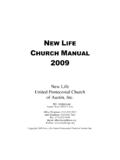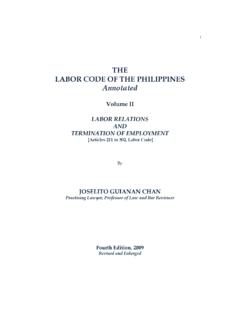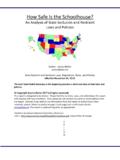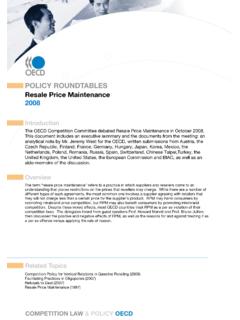Transcription of LOCAL LAWS 88 of 2009 - New York City
1 LOCAL laws . OF. THE city OF NEW york . FOR THE YEAR 2009 . _____. No. 88. _____. Introduced by Council Members Recchia, Jr., the Speaker (Council Member Quinn), Comrie, Dickens, Fidler, Garodnick, Gioia, James, Lappin, Mitchell, Nelson, Reyna, Rivera, Stewart, Liu, Yassky, Sears, White Jr., Mendez, de Blasio, Mark-Viverito, Katz, Vallone Jr., Gerson, Koppell, Vann, Avella, Vacca, Jackson, Brewer, Gonzalez, Ferreras, Barron, Arroyo, Crowley, Gennaro and Mealy A LOCAL LAW. To amend the administrative code of the city of New york , in relation to upgrading lighting systems and the installation of sub-meters in certain buildings. Be it enacted by the Council as follows: Section 1.
2 Declaration of legislative findings and intent. The Council finds that non-residential lighting is responsible for almost 18% of the energy used in New york city 's buildings and roughly 18% of carbon emissions from buildings, that tenant electrical use can account for the majority of the electricity consumed in many large non-residential buildings, and that patterns of electrical consumption in tenant spaces are often not known by tenants. Rapid improvements in lighting technology in the past decades have made it feasible to dramatically reduce energy consumption by installing more efficient lighting systems, and any investments made to install such systems will typically be realized through operational savings.
3 Furthermore, most large buildings have one master meter for electricity that measures building-wide usage, as opposed to separate meters that provide such information on a per tenant basis. The Council finds that the consumption of energy for lighting and other electrical equipment can be reduced if code-compliant lighting is installed in non-residential spaces and electrical measuring equipment is installed and data on electrical energy use is made available to commercial tenants. 2. Chapter 3 of title 28 of the administrative code of the city of New york is amended by adding new articles 310 and 311 to read as follows: ARTICLE 310. REQUIRED UPGRADE OF LIGHTING SYSTEMS.
4 General. Lighting systems in covered buildings shall be upgraded as provided for in this article. Definitions. As used in this article, the following terms shall have the following meanings: COVERED BUILDING. As it appears in the records of the department of finance: (i) a building that exceeds 50,000 gross square feet (4645 m2), (ii) two or more buildings on the same tax lot that together exceed 100,000 gross square feet (9290 m2), or (iii) two or more buildings held in the condominium form of ownership that are governed by the same board of managers and that together exceed 100,000 gross square feet (9290 m2). Exception: The term covered building shall not include real property classified as class one pursuant to subdivision one of section 1802 of the real property tax law.
5 UPGRADE. The installation or modification of the lighting system of a covered 2. building to comply with the standards required for new systems, including all of the following elements: lighting controls (interior lighting controls, light reduction controls and automatic lighting shutoff), tandem wiring, exit signs, interior lighting power requirements and exterior lighting. Upgrade of lighting systems of covered buildings required. The lighting systems of covered buildings shall be upgraded to comply with the standards for new systems set forth in section 805 of the New york city energy conservation code and/or applicable standards referenced in such energy code on or prior to January 1, 2025.
6 The owner of a covered building shall ensure that the upgrade of the lighting system of the entire covered building is completed on or prior to such date and shall file a report with the department, on or prior to such date, prepared by a registered design professional or a licensed master or special electrician certifying that such upgrade has been completed and that the work is in compliance with the technical standards of the New york city electrical code. The department may impose a fee for filing and review of such reports. Exceptions: 1. No upgrade is required for (i) an element of a lighting system that is in compliance with the standards of the New york city energy conservation code and/or applicable standards referenced in such code as in effect for new systems installed on or after July 1, 2010, or (ii) lighting power densities in any space bounded by permanent floor- to-ceiling partitions and/or closable doors that are in compliance with the standards of the New york city energy conservation code and/or 3.
7 Applicable standards referenced in such code as in effect for new systems installed on or after July 1, 2010. 2. No upgrade is required for the lighting system within dwelling units classified in occupancy group R-2 or R-3 or spaces serving such dwelling units, including but not limited to, hallways, laundry rooms, or boiler rooms. 3. No upgrade is required for the lighting system within a space classified in occupancy group A-3 that is within a house of worship. ARTICLE 311. INSTALLATION OF ELECTRICAL SUB-METERS IN TENANT SPACES. General. Sub-meters shall be installed in covered buildings as provided in this article. Definitions. As used in this article, the following terms shall have the following meanings: COVERED BUILDING.
8 As it appears in the records of the department of finance: (i) a building that exceeds 50,000 gross square feet (4645 m2), (ii) two or more buildings on the same tax lot that together exceed 100,000 gross square feet (9290 m2), or (iii) two or more buildings held in the condominium form of ownership that are governed by the same board of managers and that together exceed 100,000 gross square feet (9290 m2). Exception: The term covered building shall not include real property classified as class one pursuant to subdivision one of section 1802 of the real property tax law. 4. COVERED TENANT SPACE. (i) A tenant space larger than 10,000 gross square feet (929 m2) on one or more floors of a covered building let or sublet to the same person, or (ii) a floor of a covered building larger than 10,000 gross square feet (929 m2) consisting of tenant spaces let or sublet to two or more different persons.
9 Exception: The term covered tenant space shall not include dwelling units classified in occupancy group R-2 or R-3. METER. A device installed by an electrical utility company or corporation that measures the flow of electricity supplied to a building or to a defined space within a building and used by the utility to bill consumers for electrical service. SUB-METER. A device meeting the standards of the department or, where applicable, the public service commission, installed within a building's electrical distribution system that measures the flow of electricity within a defined space within the building and that may, but need not, be used for apportioning the cost of electricity among the building's tenants or subtenants.
10 TENANT SPACE. Space within a covered building that is let or sublet to another person by the owner or a lessee of such space. Sub-meters required for covered tenant spaces. On and after January 1, 2025, the electrical consumption of each covered tenant space shall be measured by one or more sub-meters. Sub-meters shall be installed in existing covered tenant spaces by the owner or the lessor of such space on or prior to January 1, 2025 and thereafter as new covered tenant spaces are created within the building. If the covered tenant space is a floor with multiple tenancies, each 5. tenancy that is 10,000 gross square feet (929 m2) or less shall (i) have a separate sub-meter, (ii) share a sub-meter with other tenant spaces on the floor, or (iii).

















